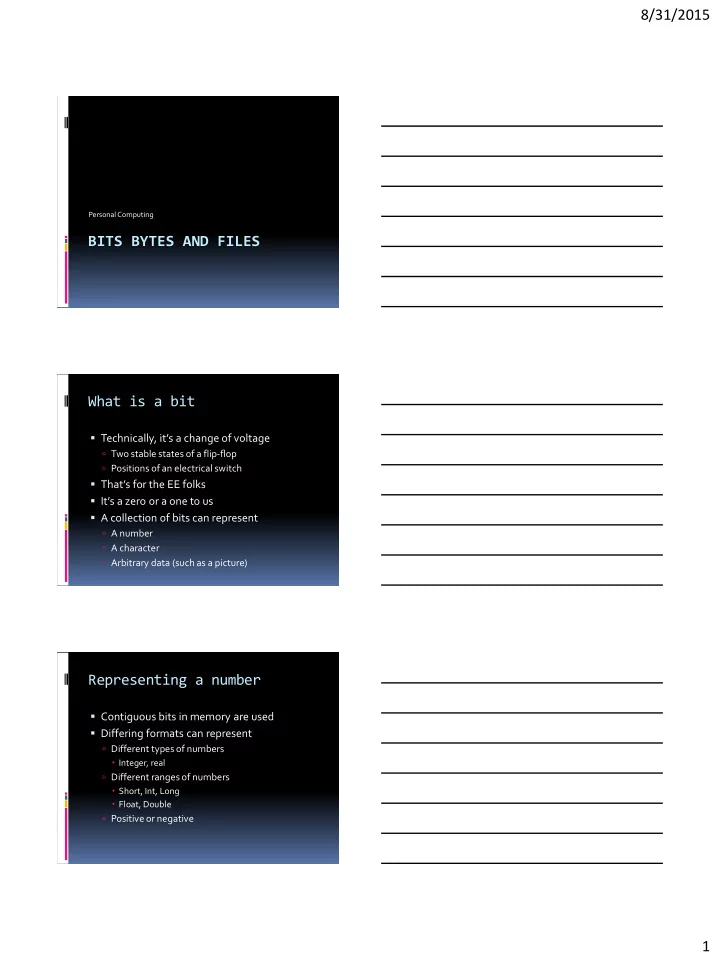

8/31/2015 Personal Computing BITS BYTES AND FILES What is a bit Technically, it’s a change of voltage Two stable states of a flip-flop Positions of an electrical switch That’s for the EE folks It’s a zero or a one to us A collection of bits can represent A number A character Arbitrary data (such as a picture) Representing a number Contiguous bits in memory are used Differing formats can represent Different types of numbers Integer, real Different ranges of numbers Short, Int, Long Float, Double Positive or negative 1
8/31/2015 Bits to Decimal 0000 = 0 0100 = 4 1000 = 8 1100 = 12 0001 = 1 0101 = 5 1001 = 9 1101 = 13 0010 = 2 0110 = 6 1010 = 10 1110 = 14 0011 = 3 0111 = 7 1011 = 11 1111 = 15 Hexidecimal representation A way of representing 4 bits with 1 character 0000 = 0 0100 = 4 1000 = 8 1100 = C 0001 = 1 0101 = 5 1001 = 9 1101 = D 0010 = 2 0110 = 6 1010 = A 1110 = E 0011 = 3 0111 = 7 1011 = B 1111 = F Representing a character Originally, 6, 7, or 8 bits Speed, speed, speed Modern systems, takes 8 bits Allows for 2 8 characters (256 differing characters) ASCII American Standard Code for Information Exchange 2
8/31/2015 ASCII Table What are files used for? To store a document Letter, resume, project document To hold a song, a movie To store a digital picture To hold a database To store an executable To store information What is a file ? A file is block of arbitrary information Usually stored in non-volatile memory Available to computer programs Based on the concept of a paper document Stored in “files” and “file cabinets” Formatted specific to the computer program 3
8/31/2015 History of the file RCA (Radio Corporation of America) ad 1950 Popular Science Vacuum memory tube Keep the results of countless computations “on file” What makes up a file? Modern files are made up of a stream of bytes Remember: A byte is 8 bits Number of bits necessary to represent one character Zero byte files are allowed Format is defined by the program Files are used to store data Most systems use extensions to identify type Common extensions .txt Text file .pdf Adobe Reader format .mp3, .wav Music .avi, .mp4 Video .html HTML file (read by browser) .c, .java Program files (C, java) .docx Word 2010 file .pptx PowerPoint 2010 file 4
8/31/2015 How is a file organized? Generally, we break files up into records Originally, a record was one line of characters Each record may or may not be different Share some trait Ex. One record per employee Organization defined by the programmer Agreed upon when multiple programmers use Example – a picture A picture is broken up into pixels Pixels are assigned X and Y coordinates 1024x1024 = 1mb picture Black and white Each pixel is assigned a 0 (black) or 1 (white) Color Palette – each pixel is assigned a value RGB – each pixel is assigned a value for each of red, green, and blue Black and white image 5
8/31/2015 Color image Example - Music Music is sounds Physical waveforms in the air Analog Created an electrical representation of the wave Playback systems recreated the physical waveform Digital Samples the waveform Records the value digitally Sound wave digitized 6
8/31/2015 Example – xml file Mechanism for moving attribute based data Ideal for: Form-based data Databases Format Attribute (metadata) is identified Value is identified XML format File size Expressed in number of bytes 7
8/31/2015 File Operations Creation Setting attributes Read Write or modify Execute Close File owner Files have an owner Usually it’s the person that created the file Can be changed to someone else Attributes are assigned By role By user account By system Permissions under Windows 8
8/31/2015 Organizing file A directory is a special type of a file Contains pointers to files Also called a catalog Files belong to folders or directories Exception is the root node Organized in a hierarchical way Make up a file system File names Local name Phase1.pdf Sammy.jpg Path name C:\My Documents\Education\Phase1.pdf C:\My Documents\Pictures\Sammy.pdf Full Pathname 9
8/31/2015 Types of file systems File Allocation Table (FAT) Memory card systems such as cameras NTFS Standard file system of Windows NT and beyond W2000, XP, Server 2003, Server 2008, Vista, Windows 7 HFS+ Mac OS Ext4 Linux Why? Why are there so many different types? History Each of the types grew from predecessors Competitive advantage Built by companies, not open source Differing feature sets Features of a file system Metadata Storage of information about the files Space management Free list, garbage list Journaling Transaction based, easy recovery Security Permissions 10
8/31/2015 Metadata Information about the files Not the files themselves Allows easy manipulation of the files Allows links to be created easily Speeds up activities with files Space management How much space is free? How much space is used? When a new file is created: Where is space created? Disk drive characteristics When a file is deleted: Is the file scrubbed? Can common areas be combined? Journaling systems Transaction based Either the write succeeds or fails Changes persist Eliminates: Missing files Missing sectors “File System fixing” progams 11
8/31/2015 Backups IMPORTANT!! Disk drives have moving parts Moving parts increase failure If data only exists on one spot, it’s lost Spend large sums of money to try to retrieve Even then, not guaranteed Disk drives are cheap, quick to back up to another one External 1TB drive - $60 References 1. http://en.wikipedia.org/wiki/File:Pcm.svg 2. http://en.wikipedia.org/wiki/Digital_audio 3. http://en.wikipedia.org/wiki/Computer_file 4. http://google.com/ 5. http://www.cheat-sheets.org/ 12
Recommend
More recommend